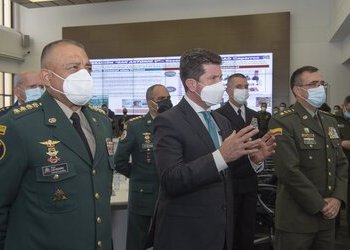The Colombian government has, rather optimistically, announced the demise of one of the country’s more aggressive criminal groups, in a region that has seen the constant recycling of criminal actors since the days of the Medellin Cartel.
On June 1, Colombia’s Defense Minister, Diego Molano, issued a video statement reporting that the Caparros, a drug trafficking group largely based in the departments of Antioquia and Córdoba, had been eliminated.
“Today, we can guarantee that the Caparros have reached the end. We do not let ourselves be distracted from our work. We will bring down all the symbols of evil,” he said, surrounded by senior military officials.
This statement came after the leader of the Caparros, Robinson Gil Tapias, alias “Flechas,” was killed by an army sniper on May 27 in Cáceres, northwestern Antioquia.
The news was celebrated by Colombian President Iván Duque who stated on Twitter that Tapias was “in charge of this criminal group’s violent actions,” and had been linked to “kidnapping, forced displacements, killings of social leaders, forced recruitment and extortion.”
SEE ALSO: Profile of the Caparros
A former member of the Urabeños until 2017, Tapias assumed command of Caparros in November 2020 after the previous leader, Emiliano Alcides Osorio, alias “Caín,” was also killed by the Colombian Army in Antioquia. There had been a reward of 500 million pesos (around $136,000) for information leading to Tapias’ apprehension.
In his statement, Molano added that the government had vowed to bring down five criminal groups, the dissidents of the demobilized Revolutionary Armed Forces of Colombia (Fuerzas Armadas Revolucionarias de Colombia – FARC); the National Liberation Army (Ejército de Liberación Nacional – ELN); the Urabeños, also known as the Clan del Golfo; the Popular Liberation Army (Ejército Popular de Liberación – EPL); and the Caparros.
InSight Crime Analysis
Having once been rising stars in Colombia’s criminal hierarchy, the Caparros has certainly been weakened by repeated security operations, losing several top leaders and fighting off larger criminal rivals.
But the fluid way in which the group was formed, its numerous alliances with other non-state armed groups and the chances that its members may be recruited elsewhere, make the government’s declaration somewhat hollow. However, facing a second month of nationwide protests and a worsening security situation, President Duque needed to claim a win.
Formerly a faction of the Urabeños, the Caparros rebelled against Urabeños leader, Dairo Antonio Úsuga alias “Otoniel,” to seize control of illegal gold mining and drug trafficking in the region of Bajo Cauca, made up of parts of both Antioquia and Córdoba.
While never the strongest group in terms of armed strength or geographical spread, it made clever, localized alliances with the ELN and ex-FARC Mafia elements to fight the common threat of the Urabeños.
However, after being targeted by repeated security operations, fighting off larger criminal threats and losing several key leaders, the Caparros have been weakened. Its base in Bajo Cauca, which is both home to coca crops and illegal gold mines, and sat astride the main road to the Caribbean Coast from Medellin, is prime criminal real estate. It has been dominated by criminal actors since the time of the Medellin Cartel. After the fall of Pablo Escobar in 1993, it became the heartland of the paramilitary United Self-Defense Forces of Colombia (Autodefensas Unidas de Colombia – AUC). After the AUC’s demobilization, the region became home to a number of criminal groups, including the Rastrojos and the ELN.
Bajo Cauca has seen endless wars for control and is currently home to at least four different criminal groups. In 2021, for example, the Nudo de Paramillo, which abuts Bajo Cauca and is one of Colombia’s most important drug trafficking and illegal mining regions, saw advances by the Urabeños and the ex-FARC Mafia’s 18th and 52nd Fronts with the Caparros seemingly unable to keep up. The ELN also has a presence in Bajo Cauca.
SEE ALSO: Caparrapos Thriving in Colombia Due to Alliances With ELN, Ex-FARC Mafia
The weakening of the former FARC 18th Front, a key ally, after a sustained military campaign in 2020 has only left the Caparros more vulnerable.
There is little doubt the government’s security operations have lessened the Caparros’ status as a national security threat. There are currently no accurate estimates for the number of men the group may still have or the amount of land it controls.
But the factors that have weakened the Caparros are not irreversible. The government always has shifting security priorities and may now move attention away from Bajo Cauca, allowing the Caparros room to reform or rebrand themselves. The Urabeños are deploying men and resources to push into other departments across Colombia. And with the plethora of drug trafficking and illegal mining options always available, the criminal economies in the region remain intact.

